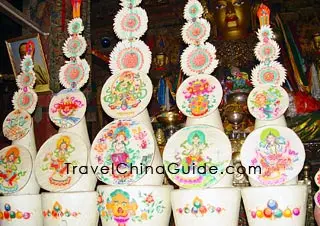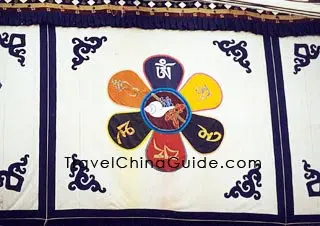Butter Sculpture and Mandala
Butter Sculpture
 |
| Butter Sculpture |
Butter sculptures are modeled by hands. Since butter melts easily, monk artists making butter sculptures need to work in cold conditions, they have to dip their hands into cold water to make their fingers cold enough then can they start to model. Monks take great pride to do the religious work. A few tools, such as hollow bones for making long threads and moulds for making leaves and alike, are applied.
The butter sculptures in Ta'er Monastery enjoy the highest reputation in the Tibetan world. The monastery has a butter sculpture museum housing a collection of fine butter sculptures.
Mandala
 |
| Mandala in Jokhang Temple |
Mandalas are usually symmetric with series of concentric circles and squares. The center point is the residence of the resident deity, from whom the Mandala is identified. Lines are drawn from the centre until they intersect and form circles and squares. The finished Mandalas have four gates, which symbolize a culmination of the four virtues: compassion, kindness, sympathy and equanimity. Other Buddhist auspicious symbols can also be included in the design. Form and color application techniques are strictly followed in the process of creating a Mandala to show religious meanings.
- Last updated on Aug. 15, 2025 by Demi Li -